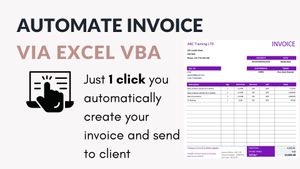In today's fast-paced business environment, efficiency and productivity are key factors that can make or break a company's success. One area that often consumes valuable time and resources is the process of generating and sending invoices to customers. However, thanks to advancements in technology and automation, businesses can now streamline this task, saving time, reducing errors, and improving customer satisfaction. In this blog post, we will explore the power of automation in generating invoices, filling up templates, and effortlessly emailing them to multiple customers with just a single click.
- Simplifying Invoice Generation: Traditionally, creating invoices required manual entry of customer information, invoice details, and calculations. This manual process was not only time-consuming but also prone to errors. Automation simplifies this process by extracting customer data from a centralized database and populating it directly into an invoice template. By eliminating manual data entry, businesses can significantly reduce the risk of errors and accelerate the invoicing process.
- Dynamic Templates for Personalized Invoices: Automation allows businesses to create dynamic invoice templates that adapt to each customer's unique requirements. These templates can include personalized details such as customer names, addresses, and specific terms of service. By tailoring the invoice to each customer, businesses can enhance their professionalism, build stronger relationships, and demonstrate a commitment to meeting individual needs.
- Efficient Calculation and Total Amount Due: With automation, complex calculations and totalling of amounts due can be performed accurately and instantly. The system can automatically calculate taxes, discounts, and any additional charges, ensuring that the final amount due is correct. This eliminates the need for manual calculations and minimizes the risk of errors, saving time and preventing payment disputes.
- Email Integration for Seamless Delivery: Once the invoice is generated and the template filled, automation can take it a step further by seamlessly integrating with email systems. With a single click, businesses can trigger the delivery of invoices via email to multiple customers simultaneously. The system can automatically attach the invoice, populate the subject line with relevant information (e.g., customer name and invoice number), and personalize the email body. This not only saves time but also ensures prompt delivery, increasing the chances of on-time payments.
- Enhanced Customer Communication: Automation goes beyond generating invoices; it also enables businesses to improve customer communication. Automated email templates can be customized to include friendly greetings, payment instructions, and contact information for customer support. Additionally, businesses can include personalized messages that address specific customer needs, showcase appreciation for their loyalty, or offer incentives for early payments. These thoughtful touches can strengthen customer relationships and enhance the overall customer experience.

